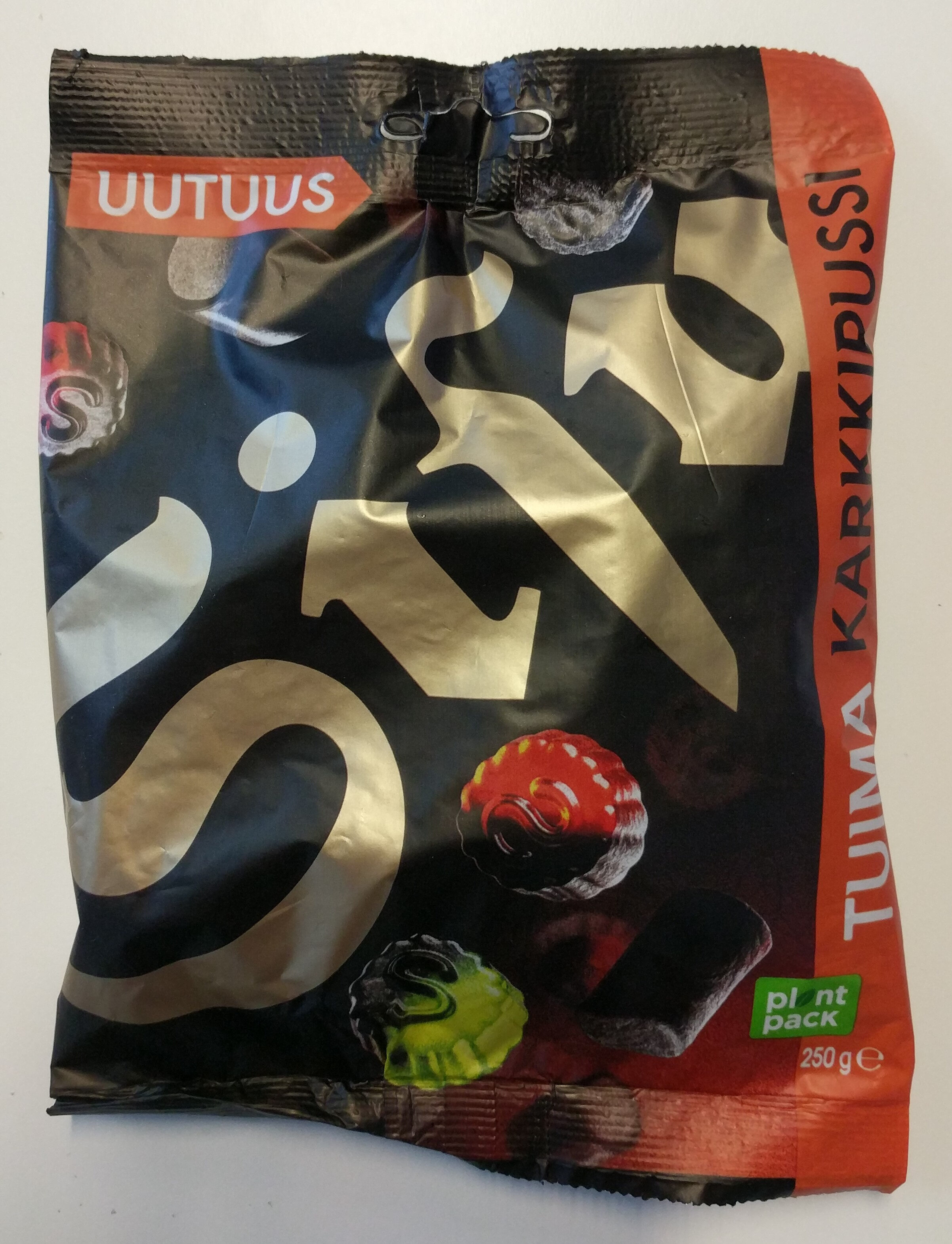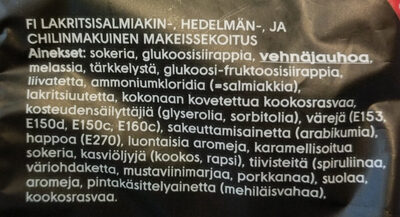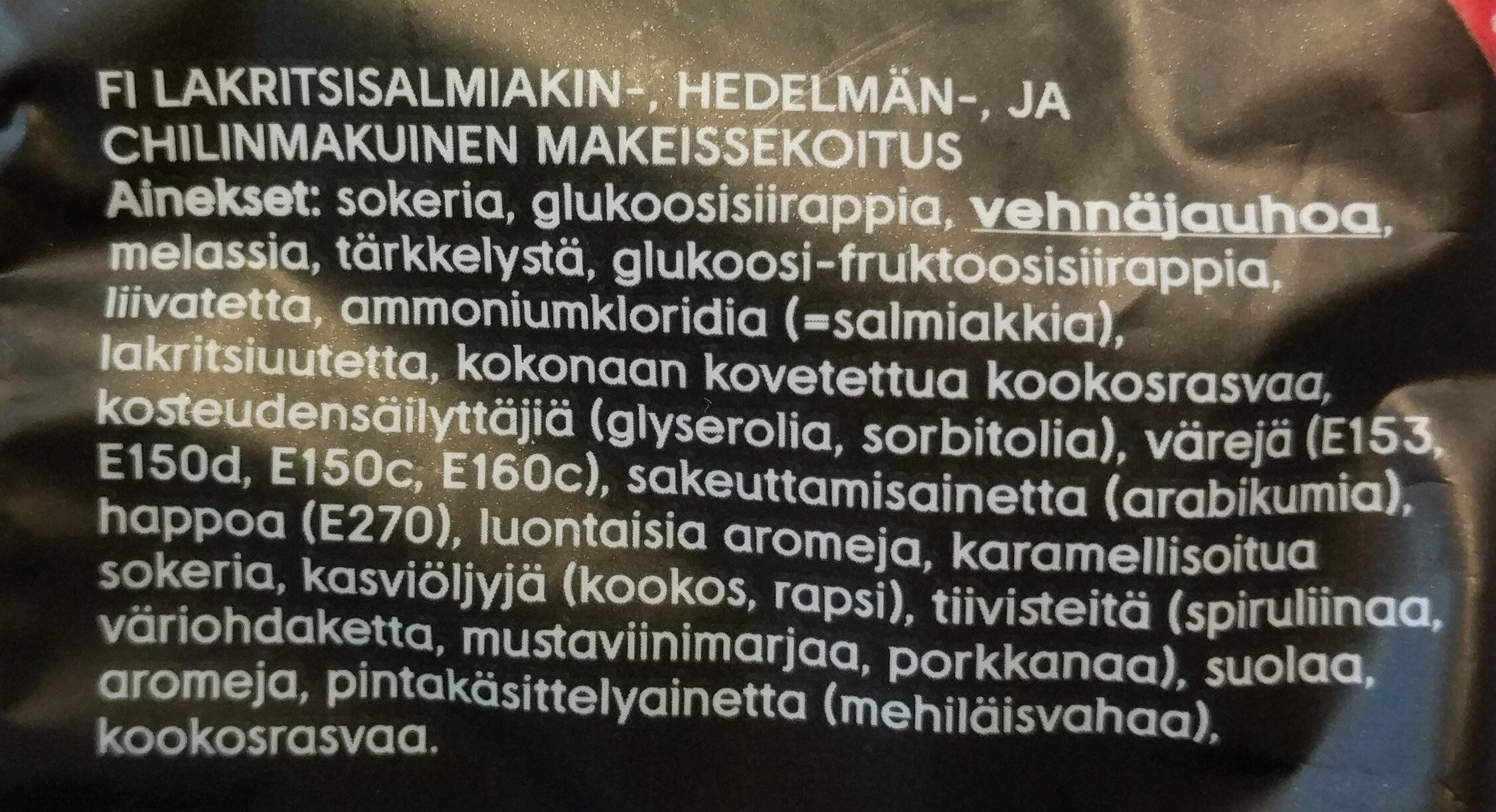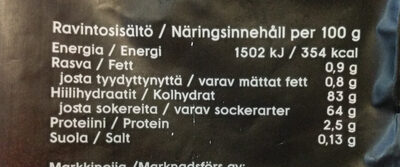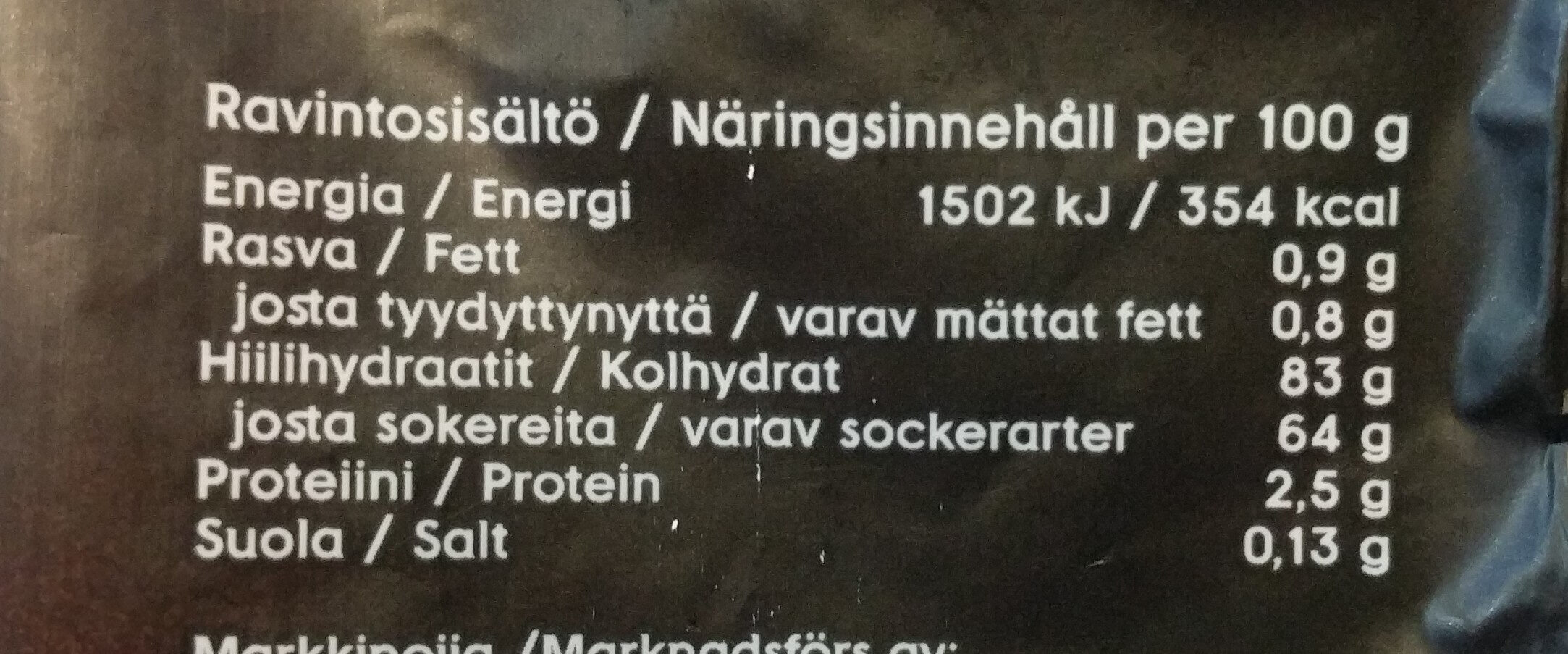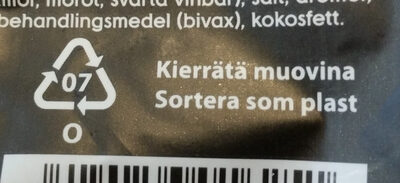Help us make food transparency the norm!
As a non-profit organization, we depend on your donations to continue informing consumers around the world about what they eat.
The food revolution starts with you!
Sisu Tuima - 250 g
Sisu Tuima - 250 g
This product page is not complete. You can help to complete it by editing it and adding more data from the photos we have, or by taking more photos using the app for Android or iPhone/iPad. Thank you!
×
Streckkod: 6420256016251 (EAN / EAN-13)
Kvantitet: 250 g
Förpackning: Plast, en:other-plastics
Kategorier: Snacks, Söta snacks, Konfekt, Godis
Länk till produktsidan på producentens officiella webbplats: https://www.cloetta.fi/tuotteet/makeispu...
Butiker: K-Supermarket
Länder där såld: Finland
Matching with your preferences
Hälsa
Ingredienser
-
38 ingredienser
: Sokeri, glukoosisiirappi, vehnäjauho, melassi, tärkkelys, glukoosi-fruktoosisiirappi, liivate, ammoniumkloridi (salmiakki), lakritsiuute, kokonaan kovetettu kookosrasva, kosteudensäilyttäjät (glyseroli, sorbitoli), värit (E153, E150d, E150c, E160c), sakeuttamisaine (arabikumia), happo (E270), luontaiset aromit, karamellisoitu sokeri, kasviöljyt (kookos, rapsi), hedelmä - ja kasvistiivisteet (spirulina, väriohdake, mustaviinimarja, porkkana), suola, aromit, pintakäsittelyaine (mehiläisvaha), kookosrasvaAllergener: Gluten
Food processing
-
Ultra processed foods
Elements that indicate the product is in the 4 - Ultra bearbetade livsmedel och drycker group:
- Tillsats: E150c - Ammoniakprocessen
- Tillsats: E150d - Ammoniaksulfitprocessen
- Tillsats: E153 - Vegetabiliskt kol
- Tillsats: E160c - Paprikaoleoresin
- Tillsats: E414 - Gummi arabicum
- Tillsats: E420 - Sorbitol
- Tillsats: E422 - Glycerol
- Tillsats: E428 - Gelatin
- Tillsats: E901 - Bivax vitt och gult
- Ingrediens: Färg
- Ingrediens: Arom
- Ingrediens: Ytbehandlingsmedel
- Ingrediens: Glukos
- Ingrediens: Glukossirap
- Ingrediens: Fuktighetsbevarande medel
- Ingrediens: Förtjockningsmedel
Food products are classified into 4 groups according to their degree of processing:
- Obearbetade eller minimalt bearbetade livsmedel
- Bearbetade kulinariska ingredienser
- Halvfabrikat
- Ultra processed foods
The determination of the group is based on the category of the product and on the ingredients it contains.
Tillsatser
-
E270 - Mjölksyra
Lactic acid: Lactic acid is an organic compound with the formula CH3CH-OH-COOH. In its solid state, it is white and water-soluble. In its liquid state, it is colorless. It is produced both naturally and synthetically. With a hydroxyl group adjacent to the carboxyl group, lactic acid is classified as an alpha-hydroxy acid -AHA-. In the form of its conjugate base called lactate, it plays a role in several biochemical processes. In solution, it can ionize a proton from the carboxyl group, producing the lactate ion CH3CH-OH-CO−2. Compared to acetic acid, its pKa is 1 unit less, meaning lactic acid deprotonates ten times more easily than acetic acid does. This higher acidity is the consequence of the intramolecular hydrogen bonding between the α-hydroxyl and the carboxylate group. Lactic acid is chiral, consisting of two optical isomers. One is known as L--+--lactic acid or -S--lactic acid and the other, its mirror image, is D--−--lactic acid or -R--lactic acid. A mixture of the two in equal amounts is called DL-lactic acid, or racemic lactic acid. Lactic acid is hygroscopic. DL-lactic acid is miscible with water and with ethanol above its melting point which is around 17 or 18 °C. D-lactic acid and L-lactic acid have a higher melting point. In animals, L-lactate is constantly produced from pyruvate via the enzyme lactate dehydrogenase -LDH- in a process of fermentation during normal metabolism and exercise. It does not increase in concentration until the rate of lactate production exceeds the rate of lactate removal, which is governed by a number of factors, including monocarboxylate transporters, concentration and isoform of LDH, and oxidative capacity of tissues. The concentration of blood lactate is usually 1–2 mM at rest, but can rise to over 20 mM during intense exertion and as high as 25 mM afterward. In addition to other biological roles, L-lactic acid is the primary endogenous agonist of hydroxycarboxylic acid receptor 1 -HCA1-, which is a Gi/o-coupled G protein-coupled receptor -GPCR-.In industry, lactic acid fermentation is performed by lactic acid bacteria, which convert simple carbohydrates such as glucose, sucrose, or galactose to lactic acid. These bacteria can also grow in the mouth; the acid they produce is responsible for the tooth decay known as caries. In medicine, lactate is one of the main components of lactated Ringer's solution and Hartmann's solution. These intravenous fluids consist of sodium and potassium cations along with lactate and chloride anions in solution with distilled water, generally in concentrations isotonic with human blood. It is most commonly used for fluid resuscitation after blood loss due to trauma, surgery, or burns.Källa: Wikipedia (Engelska)
-
E414 - Gummi arabicum
Gum arabic: Gum arabic, also known as acacia gum, arabic gum, gum acacia, acacia, Senegal gum and Indian gum, and by other names, is a natural gum consisting of the hardened sap of various species of the acacia tree. Originally, gum arabic was collected from Acacia nilotica which was called the "gum arabic tree"; in the present day, gum arabic is collected from acacia species, predominantly Acacia senegal and Vachellia -Acacia- seyal; the term "gum arabic" does not indicate a particular botanical source. In a few cases so‐called "gum arabic" may not even have been collected from Acacia species, but may originate from Combretum, Albizia or some other genus. Producers harvest the gum commercially from wild trees, mostly in Sudan -80%- and throughout the Sahel, from Senegal to Somalia—though it is historically cultivated in Arabia and West Asia. Gum arabic is a complex mixture of glycoproteins and polysaccharides. It is the original source of the sugars arabinose and ribose, both of which were first discovered and isolated from it, and are named after it. Gum arabic is soluble in water. It is edible, and used primarily in the food industry as a stabilizer, with EU E number E414. Gum arabic is a key ingredient in traditional lithography and is used in printing, paint production, glue, cosmetics and various industrial applications, including viscosity control in inks and in textile industries, though less expensive materials compete with it for many of these roles. While gum arabic is now produced throughout the African Sahel, it is still harvested and used in the Middle East.Källa: Wikipedia (Engelska)
-
E420 - Sorbitol
Sorbitol: Sorbitol --, less commonly known as glucitol --, is a sugar alcohol with a sweet taste which the human body metabolizes slowly. It can be obtained by reduction of glucose, which changes the aldehyde group to a hydroxyl group. Most sorbitol is made from corn syrup, but it is also found in nature, for example in apples, pears, peaches, and prunes. It is converted to fructose by sorbitol-6-phosphate 2-dehydrogenase. Sorbitol is an isomer of mannitol, another sugar alcohol; the two differ only in the orientation of the hydroxyl group on carbon 2. While similar, the two sugar alcohols have very different sources in nature, melting points, and uses.Källa: Wikipedia (Engelska)
-
E422 - Glycerol
Glycerol: Glycerol -; also called glycerine or glycerin; see spelling differences- is a simple polyol compound. It is a colorless, odorless, viscous liquid that is sweet-tasting and non-toxic. The glycerol backbone is found in all lipids known as triglycerides. It is widely used in the food industry as a sweetener and humectant and in pharmaceutical formulations. Glycerol has three hydroxyl groups that are responsible for its solubility in water and its hygroscopic nature.Källa: Wikipedia (Engelska)
-
E901 - Bivax vitt och gult
Beeswax: Beeswax -cera alba- is a natural wax produced by honey bees of the genus Apis. The wax is formed into "scales" by eight wax-producing glands in the abdominal segments of worker bees, which discard it in or at the hive. The hive workers collect and use it to form cells for honey storage and larval and pupal protection within the beehive. Chemically, beeswax consists mainly of esters of fatty acids and various long-chain alcohols. Beeswax has long-standing applications in human food and flavoring. For example, it is used as a glazing agent or as a light/heat source. It is edible, in the sense of having similar negligible toxicity to plant waxes, and is approved for food use in most countries and the European Union under the E number E901. However, the wax monoesters in beeswax are poorly hydrolysed in the guts of humans and other mammals, so they have insignificant nutritional value. Some birds, such as honeyguides, can digest beeswax. Beeswax is the main diet of wax moth larvae.Källa: Wikipedia (Engelska)
Ingrediensanalys
-
Palmoljefri
No ingredients containing palm oil detected
-
Icke-vegan
Non-vegan ingredients: E428, E901
-
Icke-vegetarisk
Non-vegetarian ingredients: E428
-
Details of the analysis of the ingredients
: Sokeri, glukoosisiirappi, _vehnäjauho_, melassi, tärkkelys, glukoosi-fruktoosisiirappi, liivate, ammoniumkloridi (salmiakki), lakritsiuute, kokonaan kovetettu kookosrasva, kosteudensäilyttäjät (glyseroli, sorbitoli), värit (e153, e150d, e150c, e160c), sakeuttamisaine (arabikumia), happo (e270), luontaiset aromit, karamellisoitu sokeri, kasviöljyt (kookos, rapsi), hedelmä-ja kasvistiivisteet (spirulina, väriohdake, mustaviinimarja, porkkana), suola, aromit, pintakäsittelyaine (mehiläisvaha), kookosrasva- Sokeri -> en:sugar - vegan: yes - vegetarian: yes - ciqual_proxy_food_code: 31016 - percent_min: 4.54545454545455 - percent_max: 100
- glukoosisiirappi -> en:glucose-syrup - vegan: yes - vegetarian: yes - ciqual_proxy_food_code: 31016 - percent_min: 0 - percent_max: 50
- _vehnäjauho_ -> en:wheat-flour - vegan: yes - vegetarian: yes - ciqual_proxy_food_code: 9410 - percent_min: 0 - percent_max: 33.3333333333333
- melassi -> en:molasses - vegan: yes - vegetarian: yes - ciqual_proxy_food_code: 31016 - percent_min: 0 - percent_max: 25
- tärkkelys -> en:starch - vegan: yes - vegetarian: yes - ciqual_proxy_food_code: 9510 - percent_min: 0 - percent_max: 20
- glukoosi-fruktoosisiirappi -> en:glucose-fructose-syrup - vegan: yes - vegetarian: yes - ciqual_food_code: 31077 - percent_min: 0 - percent_max: 16.6666666666667
- liivate -> en:e428 - vegan: no - vegetarian: no - percent_min: 0 - percent_max: 14.2857142857143
- ammoniumkloridi -> en:e510 - vegan: yes - vegetarian: yes - percent_min: 0 - percent_max: 12.5
- salmiakki -> en:e510 - vegan: yes - vegetarian: yes - percent_min: 0 - percent_max: 12.5
- lakritsiuute -> en:liquorice-extract - vegan: yes - vegetarian: yes - percent_min: 0 - percent_max: 11.1111111111111
- kokonaan kovetettu kookosrasva -> en:fully-hydrogenated-coconut-fat - vegan: yes - vegetarian: yes - from_palm_oil: no - ciqual_food_code: 16040 - percent_min: 0 - percent_max: 10
- kosteudensäilyttäjät -> en:humectant - percent_min: 0 - percent_max: 9.09090909090909
- glyseroli -> en:e422 - vegan: maybe - vegetarian: maybe - percent_min: 0 - percent_max: 9.09090909090909
- sorbitoli -> en:e420 - vegan: yes - vegetarian: yes - percent_min: 0 - percent_max: 4.54545454545455
- värit -> en:colour - percent_min: 0 - percent_max: 8.33333333333333
- e153 -> en:e153 - vegan: yes - vegetarian: yes - percent_min: 0 - percent_max: 8.33333333333333
- e150d -> en:e150d - vegan: yes - vegetarian: yes - percent_min: 0 - percent_max: 4.16666666666667
- e150c -> en:e150a - vegan: yes - vegetarian: yes - percent_min: 0 - percent_max: 2.77777777777778
- e160c -> en:e160c - vegan: yes - vegetarian: yes - percent_min: 0 - percent_max: 2.08333333333333
- sakeuttamisaine -> en:thickener - percent_min: 0 - percent_max: 7.69230769230769
- arabikumia -> en:e414 - vegan: yes - vegetarian: yes - percent_min: 0 - percent_max: 7.69230769230769
- happo -> en:acid - percent_min: 0 - percent_max: 7.14285714285714
- e270 -> en:e270 - vegan: yes - vegetarian: yes - percent_min: 0 - percent_max: 7.14285714285714
- luontaiset aromit -> en:natural-flavouring - vegan: maybe - vegetarian: maybe - percent_min: 0 - percent_max: 5
- karamellisoitu sokeri -> en:caramelised-sugar - vegan: yes - vegetarian: yes - ciqual_proxy_food_code: 31016 - percent_min: 0 - percent_max: 5
- kasviöljyt -> en:vegetable-oil - vegan: yes - vegetarian: yes - from_palm_oil: maybe - percent_min: 0 - percent_max: 5
- kookos -> en:coconut - vegan: yes - vegetarian: yes - ciqual_proxy_food_code: 15006 - percent_min: 0 - percent_max: 5
- rapsi -> en:rapeseed - vegan: yes - vegetarian: yes - percent_min: 0 - percent_max: 2.5
- hedelmä-ja kasvistiivisteet -> en:fruit-and-vegetable-concentrates - vegan: yes - vegetarian: yes - percent_min: 0 - percent_max: 5
- spirulina -> en:spirulina - vegan: yes - vegetarian: yes - ciqual_proxy_food_code: 20984 - percent_min: 0 - percent_max: 5
- väriohdake -> en:safflower - vegan: yes - vegetarian: yes - percent_min: 0 - percent_max: 2.5
- mustaviinimarja -> en:blackcurrant - vegan: yes - vegetarian: yes - ciqual_food_code: 13007 - percent_min: 0 - percent_max: 1.66666666666667
- porkkana -> en:carrot - vegan: yes - vegetarian: yes - ciqual_food_code: 20009 - percent_min: 0 - percent_max: 1.25
- suola -> en:salt - vegan: yes - vegetarian: yes - ciqual_food_code: 11058 - percent_min: 0 - percent_max: 0.13
- aromit -> en:flavouring - vegan: maybe - vegetarian: maybe - percent_min: 0 - percent_max: 0.13
- pintakäsittelyaine -> en:glazing-agent - percent_min: 0 - percent_max: 0.13
- mehiläisvaha -> en:e901 - vegan: no - vegetarian: yes - percent_min: 0 - percent_max: 0.13
- kookosrasva -> en:coconut-fat - vegan: yes - vegetarian: yes - from_palm_oil: no - ciqual_food_code: 16040 - percent_min: 0 - percent_max: 0.13
Näring
-
Poor nutritional quality
⚠ ️Varning: mängden fibrer är inte angiven, eventuella positiv inverkan på betyget kunde inte beaktas.⚠ ️Warning: the amount of fruits, vegetables and nuts is not specified on the label, it was estimated from the list of ingredients: 0This product is not considered a beverage for the calculation of the Nutri-Score.
Positiva poäng: 0
- Proteiner: 1 / 5 (värde: 2.5, avrundat värde: 2.5)
- Fiber: 0 / 5 (värde: 0, avrundat värde: 0)
- Frukt, grönsaker, nötter och raps- / valnöt- / olivoljor: 0 / 5 (värde: 0.00109239058061661, avrundat värde: 0)
Negativa poäng: 14
- Energi: 4 / 10 (värde: 1502, avrundat värde: 1502)
- Socker: 10 / 10 (värde: 64, avrundat värde: 64)
- Mättat fett: 0 / 10 (värde: 0.8, avrundat värde: 0.8)
- Natrium: 0 / 10 (värde: 52, avrundat värde: 52)
The points for proteins are not counted because the negative points are greater or equal to 11.
Näringsvärde: (14 - 0)
Nutri-Score:
-
Näringsvärden
-
Fett i låg kvantitet (0.9%)
What you need to know- A high consumption of fat, especially saturated fats, can raise cholesterol, which increases the risk of heart diseases.
Recommendation: Limit the consumption of fat and saturated fat- Choose products with lower fat and saturated fat content.
-
Mättat fett i låg kvantitet (0.8%)
What you need to know- A high consumption of fat, especially saturated fats, can raise cholesterol, which increases the risk of heart diseases.
Recommendation: Limit the consumption of fat and saturated fat- Choose products with lower fat and saturated fat content.
-
Sockerarter i hög kvantitet (64%)
What you need to know- A high consumption of sugar can cause weight gain and tooth decay. It also augments the risk of type 2 diabetes and cardio-vascular diseases.
Recommendation: Limit the consumption of sugar and sugary drinks- Sugary drinks (such as sodas, fruit beverages, and fruit juices and nectars) should be limited as much as possible (no more than 1 glass a day).
- Choose products with lower sugar content and reduce the consumption of products with added sugars.
-
Salt i låg kvantitet (0.13%)
What you need to know- A high consumption of salt (or sodium) can cause raised blood pressure, which can increase the risk of heart disease and stroke.
- Many people who have high blood pressure do not know it, as there are often no symptoms.
- Most people consume too much salt (on average 9 to 12 grams per day), around twice the recommended maximum level of intake.
Recommendation: Limit the consumption of salt and salted food- Reduce the quantity of salt used when cooking, and don't salt again at the table.
- Limit the consumption of salty snacks and choose products with lower salt content.
-
-
Näringsfakta
Näringsfakta Som såld
för 100 g / 100 mlCompared to: Godis Energi 1 502 kj
(354 kcal)+3 % Fett 0,9 g −47 % Mättat fett 0,8 g −22 % Kolhydrat 83 g +3 % Sockerarter 64 g +18 % Fiber ? Protein 2,5 g −2 % Salt 0,13 g −43 % Fruits‚ vegetables‚ nuts and rapeseed‚ walnut and olive oils (estimate from ingredients list analysis) 0,001 %
Miljö
-
Eco-Score C - Måttlig miljöpåverkan
The Eco-Score is an experimental score that summarizes the environmental impacts of food products.→ The Eco-Score was initially developped for France and it is being extended to other European countries. The Eco-Score formula is subject to change as it is regularly improved to make it more precise and better suited to each country.Life cycle analysis
-
Average impact of products of the same category: B (Score: 62/100)
Kategori: Candies, all types
Kategori: Candies, all types
- PEF environmental score: 0.41 (the lower the score, the lower the impact)
- including impact on climate change: 1.73 kg CO2 eq/kg of product
Stage Impact Jordbruk
78.2 %Bearbetar
10.7 %Förpackning
5.5 %Transportation
4.5 %Distribution
1.1 %Consumption
0.0 %
Bonuses and maluses
-
Missing origins of ingredients information
Malus: -5
⚠ ️ The origins of the ingredients of this product are not indicated.
If they are indicated on the packaging, you can modify the product sheet and add them.
If you are the manufacturer of this product, you can send us the information with our free platform for producers.
-
Packaging with a medium impact
Malus: -10
Form Material Återvinning Impact Okänd 07 OTHER Hög ⚠ ️ The information about the packaging of this product is not sufficiently precise (exact shapes and materials of all components of the packaging).⚠ ️ For a more precise calculation of the Eco-Score, you can modify the product page and add them.
If you are the manufacturer of this product, you can send us the information with our free platform for producers.
Eco-Score for this product
-
Impact for this product: C (Score: 47/100)
Produkt: Sisu Tuima - 250 g
Life cycle analysis score: 62
Sum of bonuses and maluses: -15
Final score: 47/100
-
Carbon footprint
-
Equal to driving 0.9 km in a petrol car
173 g CO² per 100g of product
The carbon emission figure comes from ADEME's Agribalyse database, for the category: Candies, all types (Source: ADEME Agribalyse Database)
Stage Impact Jordbruk
52.3 %Bearbetar
19.5 %Förpackning
15.7 %Transportation
11.6 %Distribution
1.0 %Consumption
0.0 %
Förpackning
-
Packaging with a medium impact
-
Packaging parts
(07 OTHER)
-
Packaging materials
Material % Packaging weight Packaging weight per 100 g of product Plast
-
Transportation
-
Origins of ingredients
Missing origins of ingredients information
⚠ ️ The origins of the ingredients of this product are not indicated.
If they are indicated on the packaging, you can modify the product sheet and add them.
If you are the manufacturer of this product, you can send us the information with our free platform for producers.Add the origins of ingredients for this product Add the origins of ingredients for this product
Report a problem
-
Incomplete or incorrect information?
Category, labels, ingredients, allergens, nutritional information, photos etc.
If the information does not match the information on the packaging, please complete or correct it. Open Food Facts is a collaborative database, and every contribution is useful for all.
Datakällor
Produkt tillagd den av mvainola
Senast ändrad produktsida på av mvainola.
Produktsida också redigerad av openfoodfacts-contributors, roboto-app.

